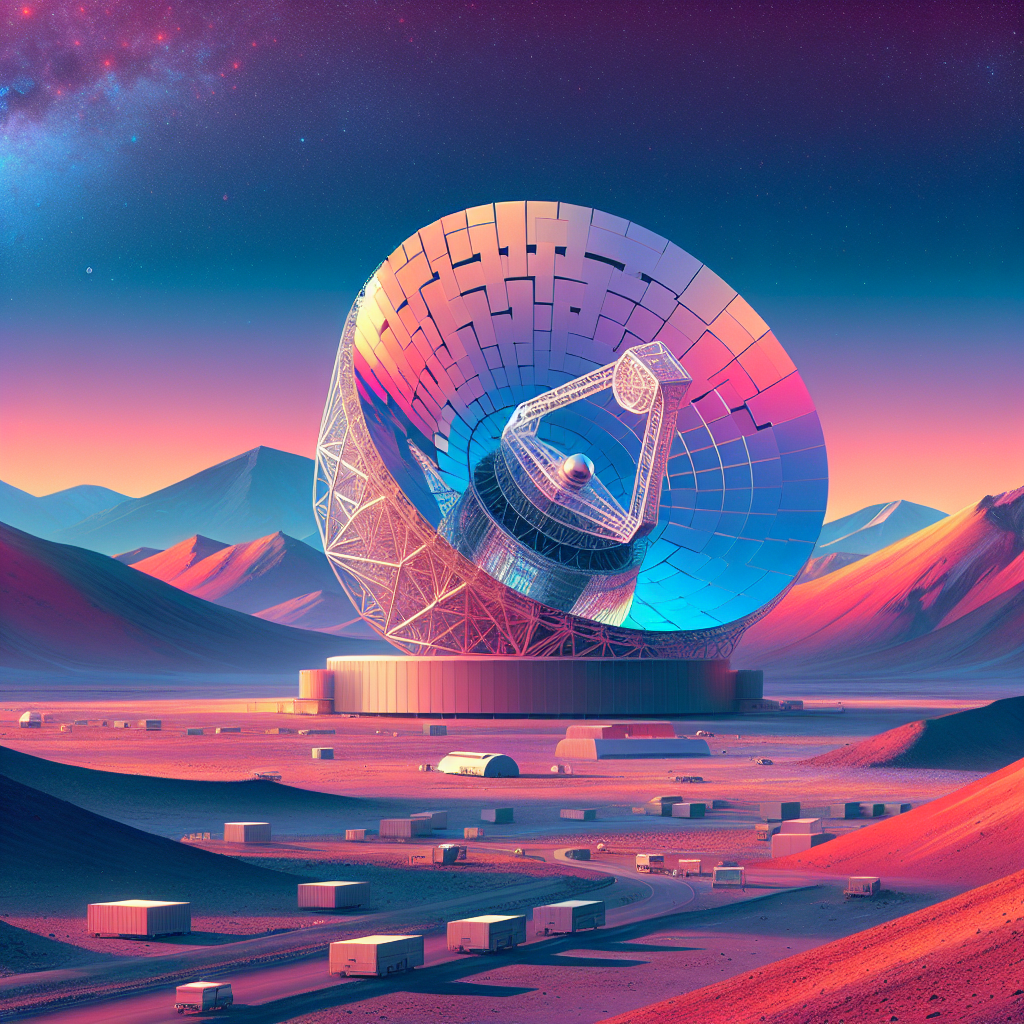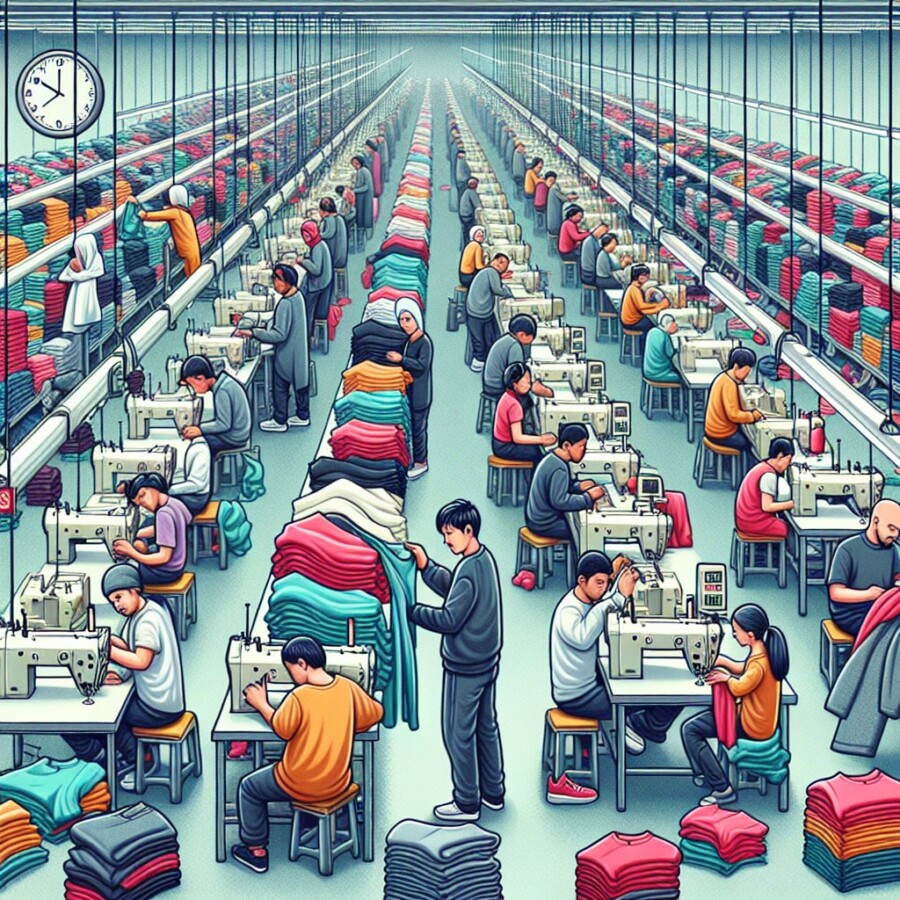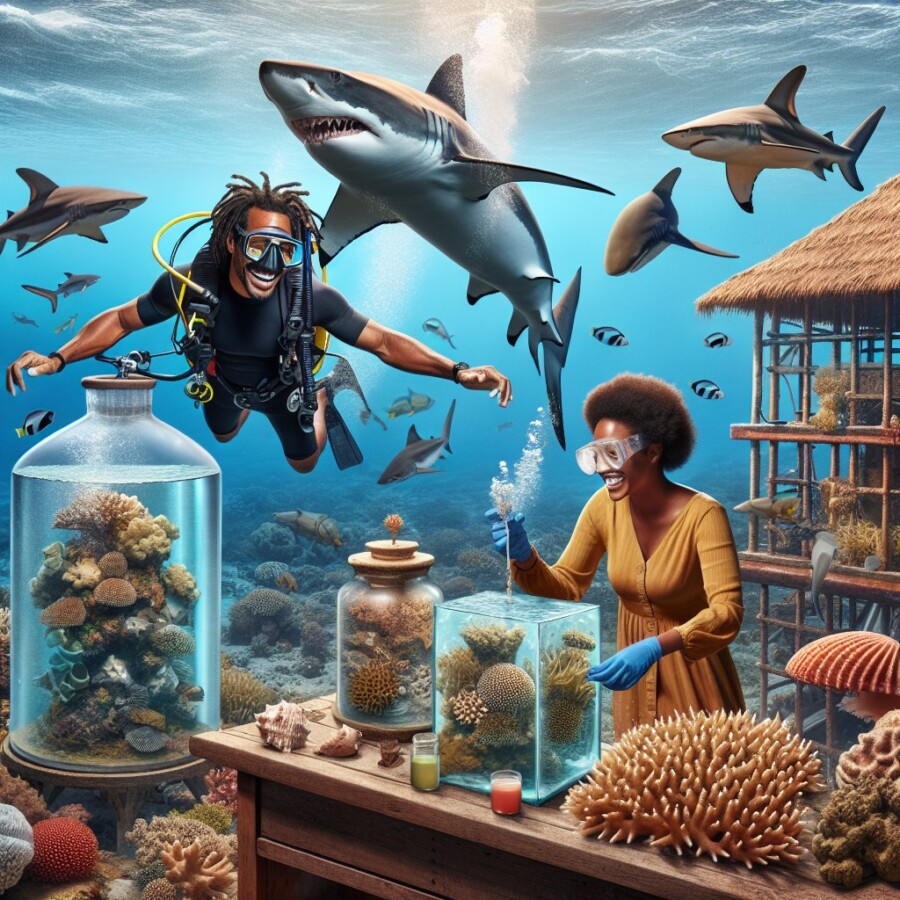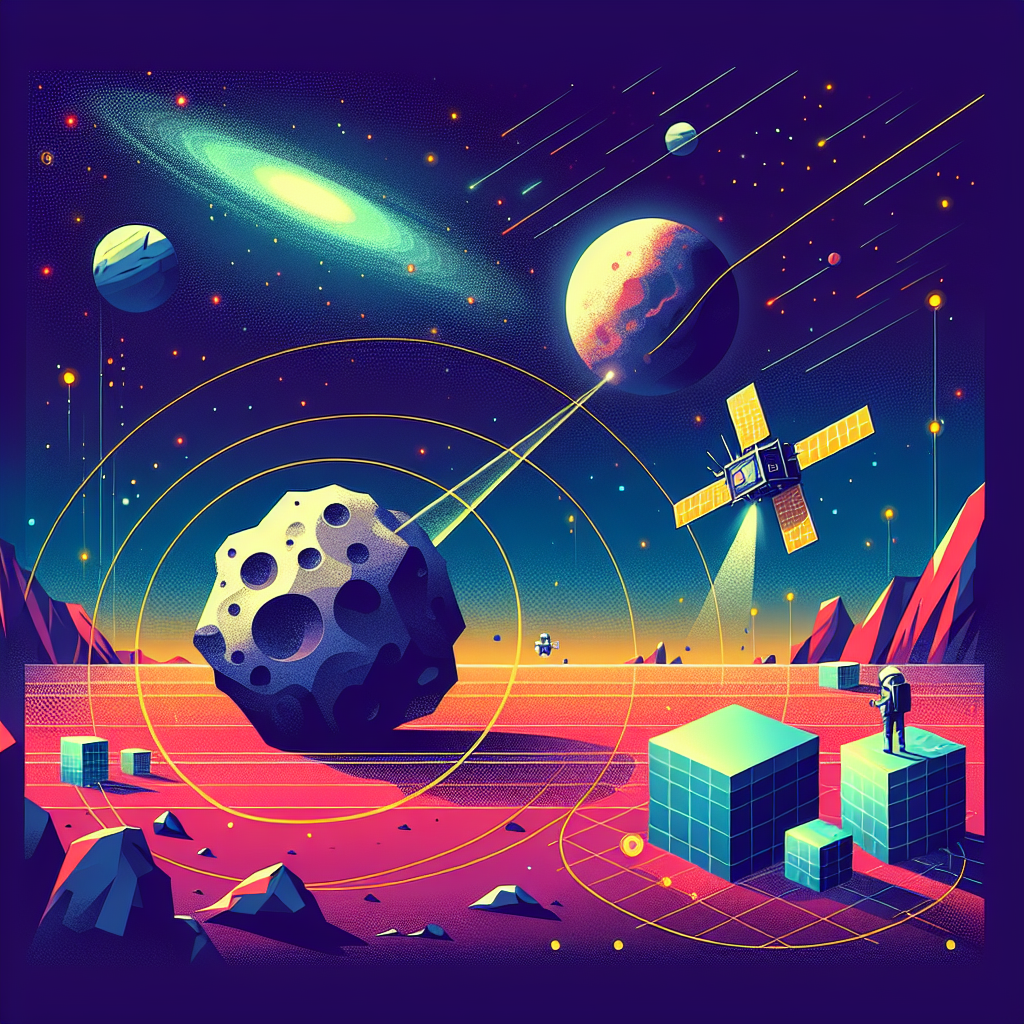In the arid Atacama desert in Chile, the European Southern Observatory (ESO) is constructing the Extremely Large Telescope (ELT), set to be the world’s largest optical telescope. Scheduled to commence operations in 2028, the ELT is expected to revolutionize our comprehension of the universe. Central to its design are five colossal mirrors, including the primary mirror, M1, which spans 39 meters in diameter and consists of 798 hexagonal segments meticulously aligned to function as a single mirror. These mirrors, crafted with unparalleled precision, will capture light from the cosmos and enhance our exploration of the universe.
Dr. Elise Vernet, an adaptive optics expert at ESO, oversees the development of the ELT’s mirrors, each a marvel of optical engineering. Notably, the M4 mirror, the largest deformable mirror ever produced, can adjust its shape 1,000 times per second to counteract atmospheric disturbances and telescope vibrations. Additionally, the Max Planck Institute for Quantum Optics has developed a quantum mirror at the atomic level, showcasing the potential for quantum technologies in the future, such as secure quantum networks for data transmission.
Further advancements in mirror technology are taking place in Oberkochen, Germany, where Zeiss is creating ultra-flat mirrors crucial for extreme ultraviolet lithography machines used in semiconductor manufacturing. These mirrors enable the printing of minuscule transistors on silicon wafers, enhancing the efficiency of computer chip production. Zeiss’s pursuit of further innovation aims to facilitate the development of microchips with one trillion transistors by 2030, a significant leap from the current technology.
The precision and capabilities of these advanced mirrors are pushing the boundaries of technology, enabling the creation of more powerful computer chips and facilitating groundbreaking discoveries in astronomy and quantum physics. The relentless pursuit of perfection in mirror design underscores the critical role mirrors play in driving technological progress and expanding our understanding of the universe. As we look ahead to the future, it is evident that mirrors will continue to be at the forefront of transformative technologies that shape our world.
Original news source: The mind-bending mirrors behind advanced technology (BBC)
🎧 Listen:
Slow
Normal
Fast
📖 Vocabulary:
| 1 | arid | Extremely dry, lacking in moisture |
| 2 | observatory | A building or place equipped for observing astronomical events |
| 3 | optical | Related to sight or vision, especially in terms of instruments |
| 4 | revolutionize | To completely change or transform something, often in a dramatic way |
| 5 | colossal | Extremely large or massive |
| 6 | meticulously | Done with great attention to detail and precision |
| 7 | unparalleled | Having no equal or match, exceptional |
| 8 | exploration | The act of traveling through or investigating an area or subject |
| 9 | adaptive | Able to adjust or change in response to different conditions |
| 10 | deformable | Capable of being reshaped or altered in form |
| 11 | atmospheric | Relating to the layer of gases surrounding the Earth |
| 12 | lithography | A printing process used to create patterns on a surface, often for electronics |
| 13 | semiconductor | A material that partially conducts electricity, used in electronic devices |
| 14 | transistors | Components in electronic devices that control the flow of electricity |
| 15 | relentless | Persistent and determined, without stopping or giving up |
Group or Classroom Activities
Warm-up Activities:
– Charades
Instructions: Divide the students into two teams. Write down key words related to the article on separate pieces of paper. One student from each team will come to the front of the class and choose a word without showing it to their team. They must then act out or mime the word while their team tries to guess. The team that guesses correctly gets a point.
– News Summary
Instructions: In pairs, have students summarize the main points of the article in their own words. Encourage them to focus on the key information such as the construction of the ELT, the innovative mirror technology, and the implications for astronomy and quantum physics. After they have discussed, ask a few pairs to share their summaries with the class.
– Opinion Poll
Instructions: Create a list of statements related to the article, such as “The construction of the ELT will significantly advance our understanding of the universe” or “Quantum mirror technology will revolutionize data transmission.” Have students move around the classroom and express their level of agreement with each statement by standing in different areas – strongly agree, agree, neutral, disagree, strongly disagree. After each statement, allow a few students to explain their opinions.
– Vocabulary Pictionary
Instructions: Write down key vocabulary words from the article on separate pieces of paper. One student at a time will pick a word and without saying it, they must draw it on the board while their classmates try to guess the word. This activity will help reinforce their understanding of the vocabulary used in the article.
– Future Predictions
Instructions: In pairs or small groups, have students discuss and make predictions about the future of mirror technology based on the information in the article. They can consider questions such as “How might mirror technology further impact astronomy in the next decade?” or “What new applications could quantum mirror technology have in the future?” After they have discussed, ask a few groups to share their predictions with the class.
🤔 Comprehension Questions:
1. What is the primary purpose of the Extremely Large Telescope (ELT) being constructed in the Atacama desert?
2. How many hexagonal segments make up the primary mirror, M1, of the ELT?
3. What is the unique feature of the M4 mirror in the ELT?
4. What potential future applications are showcased by the quantum mirror developed by the Max Planck Institute for Quantum Optics?
5. Where is Zeiss creating ultra-flat mirrors for extreme ultraviolet lithography machines, and what is the purpose of these mirrors?
6. How do the ultra-flat mirrors created by Zeiss contribute to the efficiency of computer chip production?
7. What is the ambitious goal set by Zeiss for the development of microchips by 2030?
8. How are advanced mirrors pushing the boundaries of technology in both astronomy and quantum physics, according to the article?
Go to answers ⇩
🎧✍️ Listen and Fill in the Gaps:
In the arid Atacama desert in Chile, the European Southern Observatory (ESO) is constructing the Extremely Large Telescope (ELT), set to be the world’s largest (1)______ telescope. Scheduled to commence operations in 2028, the ELT is expected to revolutionize our comprehension of the universe. Central to its design are five (2)______ (3)______, including the primary (4)______, M1, which spans 39 meters in diameter and consists of 798 hexagonal segments meticulously aligned to function as a single mirror. These mirrors, crafted with unparalleled precision, will capture light from the cosmos and enhance our (5)______ of the universe.
Dr. Elise Vernet, an adaptive optics expert at ESO, oversees the development of the ELT’s mirrors, each a marvel of optical engineering. Notably, the M4 mirror, the largest deformable mirror ever produced, can adjust its shape 1,000 times per second to counteract atmospheric disturbances and telescope (6)______. Additionally, the Max Planck Institute for Quantum (7)______ has developed a (8)______ mirror at the atomic level, showcasing the potential for quantum technologies in the future, such as secure quantum networks for data transmission.
Further advancements in mirror technology are taking place in Oberkochen, Germany, where Zeiss is creating ultra-flat mirrors crucial for (9)______ ultraviolet lithography machines used in (10)______ manufacturing. These mirrors enable the printing of minuscule (11)______ on silicon wafers, enhancing the efficiency of computer chip production. Zeiss’s pursuit of further (12)______ aims to facilitate the development of microchips with one trillion transistors by 2030, a significant leap from the current technology.
The precision and (13)______ of these advanced mirrors are pushing the boundaries of technology, (14)______ the creation of more powerful computer chips and facilitating groundbreaking discoveries in astronomy and quantum physics. The relentless pursuit of perfection in mirror design underscores the critical role mirrors play in driving technological progress and expanding our understanding of the universe. As we look ahead to the (15)______, it is evident that mirrors will (16)______ to be at the forefront of transformative technologies that shape our world.
Go to answers ⇩
💬 Discussion Questions:
Students can ask a partner these questions, or discuss them as a group.
1. What do you think about the idea of constructing such a massive telescope in the Atacama desert?
2. How would you feel if you had the opportunity to work on the development of the ELT’s mirrors?
3. Do you believe that the ELT will truly revolutionize our comprehension of the universe? Why or why not?
4. What is your opinion on the potential use of quantum technologies in the future, such as secure quantum networks for data transmission?
5. How do you think the development of ultra-flat mirrors for extreme ultraviolet lithography machines will impact semiconductor manufacturing?
6. Do you like the idea of microchips with one trillion transistors being developed by 2030? Why or why not?
7. How important do you think mirror technology is in driving technological progress and expanding our understanding of the universe?
8. What advancements in mirror technology do you think will have the most significant impact on society in the future?
9. How do you think the relentless pursuit of perfection in mirror design contributes to technological innovation?
10. Do you think the role of mirrors in astronomy and quantum physics is often overlooked in discussions about technological advancements? Why or why not?
11. How do you think the development of the ELT’s mirrors compares to other scientific advancements in recent years?
12. What challenges do you think scientists and engineers face when designing and constructing such advanced mirrors?
13. Why do you think it is important for companies like Zeiss to continue pursuing innovation in mirror technology?
14. What impact do you think the ELT and its advanced mirrors will have on future space exploration missions?
15. In your opinion, how will the use of mirrors in technology continue to evolve in the coming years?
Individual Activities
📖💭 Vocabulary Meanings:
Match each word to its meaning.
Words:
1. arid
2. observatory
3. optical
4. revolutionize
5. colossal
6. meticulously
7. unparalleled
8. exploration
9. adaptive
10. deformable
11. atmospheric
12. lithography
13. semiconductor
14. transistors
15. relentless
Meanings:
(A) The act of traveling through or investigating an area or subject
(B) A printing process used to create patterns on a surface, often for electronics
(C) Done with great attention to detail and precision
(D) A material that partially conducts electricity, used in electronic devices
(E) Having no equal or match, exceptional
(F) A building or place equipped for observing astronomical events
(G) Capable of being reshaped or altered in form
(H) Extremely dry, lacking in moisture
(I) Relating to the layer of gases surrounding the Earth
(J) Extremely large or massive
(K) Related to sight or vision, especially in terms of instruments
(L) To completely change or transform something, often in a dramatic way
(M) Persistent and determined, without stopping or giving up
(N) Components in electronic devices that control the flow of electricity
(O) Able to adjust or change in response to different conditions
Go to answers ⇩
🔡 Multiple Choice Questions:
1. What is the primary mirror of the Extremely Large Telescope (ELT) made up of?
(a) 500 circular segments
(b) 1000 triangular segments
(c) 798 hexagonal segments
(d) 200 square segments
2. When is the ELT scheduled to commence operations?
(a) 2028
(b) 2035
(c) 2040
(d) 2025
3. Who oversees the development of the ELT’s mirrors?
(a) Dr. John Smith
(b) Dr. Maria Garcia
(c) Dr. Elise Vernet
(d) Dr. David Lee
4. What is the M4 mirror capable of doing to counteract disturbances?
(a) Rotate 360 degrees
(b) Change its color
(c) Expand its size
(d) Adjust its shape 1,000 times per second
5. Where is Zeiss creating ultra-flat mirrors for extreme ultraviolet lithography machines?
(a) Paris, France
(b) Tokyo, Japan
(c) New York, USA
(d) Oberkochen, Germany
6. What is the goal of Zeiss in developing microchips by 2030?
(a) One billion transistors
(b) One trillion transistors
(c) One million transistors
(d) One hundred thousand transistors
7. What is the potential application of the quantum mirror developed by the Max Planck Institute for Quantum Optics?
(a) Secure quantum networks for data transmission
(b) Secure quantum networks for energy production
(c) Secure quantum networks for transportation
(d) Secure quantum networks for agriculture
8. What role do mirrors play in driving technological progress and expanding our understanding of the universe?
(a) Minor role
(b) Critical role
(c) Insignificant role
(d) Supportive role
Go to answers ⇩
🕵️ True or False Questions:
1. Dr. Elise Vernet, an adaptive optics expert at NASA, is overseeing the development of the ELT’s mirrors.
2. The ELT is expected to begin operations in 2030 and is anticipated to revolutionize our understanding of the solar system.
3. The primary mirror of the ELT, M1, is made up of 799 hexagonal segments meticulously aligned to function as a single mirror.
4. The M4 mirror of the ELT can adjust its shape 1,000 times per second to counteract atmospheric disturbances and telescope vibrations.
5. The Max Planck Institute for Quantum Optics has developed a quantum mirror at the atomic level, showcasing the potential for quantum technologies in the future.
6. The Extremely Large Telescope (ELT) being constructed in the Atacama desert in Chile is set to be the world’s largest optical telescope.
7. Zeiss aims to develop microchips with one trillion transistors by 2030, which would be a significant advancement from current technology.
8. Schott in Jena, Germany, is creating curved mirrors crucial for extreme ultraviolet lithography machines used in semiconductor manufacturing.
Go to answers ⇩
📝 Write a Summary:
Write a summary of this news article in two sentences.
Check your writing now with the best free AI for English writing!
Writing Questions:
Answer the following questions. Write as much as you can for each answer.
Check your answers with our free English writing assistant!
1. What is the primary purpose of the Extremely Large Telescope (ELT) being constructed in the Atacama desert in Chile?
2. How do the mirrors of the ELT, particularly the M4 mirror and the quantum mirror, demonstrate advancements in mirror technology?
3. What role do ultra-flat mirrors created by Zeiss in Germany play in semiconductor manufacturing, specifically in the production of computer chips?
4. How does the ability of the M4 mirror to adjust its shape rapidly contribute to the effectiveness of the ELT in capturing light from the cosmos?
5. In what ways are mirrors at the forefront of transformative technologies, according to the article?
✅ Answers
🤔✅ Comprehension Question Answers:
1. What is the primary purpose of the Extremely Large Telescope (ELT) being constructed in the Atacama desert?
The primary purpose of the ELT is to revolutionize our comprehension of the universe by enhancing our exploration of the cosmos.
2. How many hexagonal segments make up the primary mirror, M1, of the ELT?
The primary mirror, M1, of the ELT consists of 798 hexagonal segments.
3. What is the unique feature of the M4 mirror in the ELT?
The M4 mirror in the ELT is the largest deformable mirror ever produced, capable of adjusting its shape 1,000 times per second to counteract atmospheric disturbances and telescope vibrations.
4. What potential future applications are showcased by the quantum mirror developed by the Max Planck Institute for Quantum Optics?
The quantum mirror developed by the Max Planck Institute for Quantum Optics showcases the potential for future quantum technologies, such as secure quantum networks for data transmission.
5. Where is Zeiss creating ultra-flat mirrors for extreme ultraviolet lithography machines, and what is the purpose of these mirrors?
Zeiss is creating ultra-flat mirrors in Oberkochen, Germany, for extreme ultraviolet lithography machines used in semiconductor manufacturing. These mirrors enable the printing of minuscule transistors on silicon wafers.
6. How do the ultra-flat mirrors created by Zeiss contribute to the efficiency of computer chip production?
The ultra-flat mirrors created by Zeiss contribute to the efficiency of computer chip production by enabling the printing of minuscule transistors on silicon wafers, enhancing the manufacturing process.
7. What is the ambitious goal set by Zeiss for the development of microchips by 2030?
Zeiss aims to facilitate the development of microchips with one trillion transistors by 2030, a significant leap from current technology.
8. How are advanced mirrors pushing the boundaries of technology in both astronomy and quantum physics, according to the article?
Advanced mirrors are pushing the boundaries of technology in astronomy by capturing light from the cosmos and enhancing our exploration of the universe. In quantum physics, mirrors like the quantum mirror developed by the Max Planck Institute showcase the potential for future quantum technologies, such as secure quantum networks for data transmission.
Go back to questions ⇧
🎧✍️✅ Listen and Fill in the Gaps Answers:
(1) optical
(2) colossal
(3) mirrors
(4) mirror
(5) exploration
(6) vibrations
(7) Optics
(8) quantum
(9) extreme
(10) semiconductor
(11) transistors
(12) innovation
(13) capabilities
(14) enabling
(15) future
(16) continue
Go back to questions ⇧
📖💭✅ Vocabulary Meanings Answers:
1. arid
Answer: (H) Extremely dry, lacking in moisture
2. observatory
Answer: (F) A building or place equipped for observing astronomical events
3. optical
Answer: (K) Related to sight or vision, especially in terms of instruments
4. revolutionize
Answer: (L) To completely change or transform something, often in a dramatic way
5. colossal
Answer: (J) Extremely large or massive
6. meticulously
Answer: (C) Done with great attention to detail and precision
7. unparalleled
Answer: (E) Having no equal or match, exceptional
8. exploration
Answer: (A) The act of traveling through or investigating an area or subject
9. adaptive
Answer: (O) Able to adjust or change in response to different conditions
10. deformable
Answer: (G) Capable of being reshaped or altered in form
11. atmospheric
Answer: (I) Relating to the layer of gases surrounding the Earth
12. lithography
Answer: (B) A printing process used to create patterns on a surface, often for electronics
13. semiconductor
Answer: (D) A material that partially conducts electricity, used in electronic devices
14. transistors
Answer: (N) Components in electronic devices that control the flow of electricity
15. relentless
Answer: (M) Persistent and determined, without stopping or giving up
Go back to questions ⇧
🔡✅ Multiple Choice Answers:
1. What is the primary mirror of the Extremely Large Telescope (ELT) made up of?
Answer: (c) 798 hexagonal segments
2. When is the ELT scheduled to commence operations?
Answer: (a) 2028
3. Who oversees the development of the ELT’s mirrors?
Answer: (c) Dr. Elise Vernet
4. What is the M4 mirror capable of doing to counteract disturbances?
Answer: (d) Adjust its shape 1,000 times per second
5. Where is Zeiss creating ultra-flat mirrors for extreme ultraviolet lithography machines?
Answer: (d) Oberkochen, Germany
6. What is the goal of Zeiss in developing microchips by 2030?
Answer: (b) One trillion transistors
7. What is the potential application of the quantum mirror developed by the Max Planck Institute for Quantum Optics?
Answer: (a) Secure quantum networks for data transmission
8. What role do mirrors play in driving technological progress and expanding our understanding of the universe?
Answer: (b) Critical role
Go back to questions ⇧
🕵️✅ True or False Answers:
1. Dr. Elise Vernet, an adaptive optics expert at NASA, is overseeing the development of the ELT’s mirrors. (Answer: False)
2. The ELT is expected to begin operations in 2030 and is anticipated to revolutionize our understanding of the solar system. (Answer: False)
3. The primary mirror of the ELT, M1, is made up of 799 hexagonal segments meticulously aligned to function as a single mirror. (Answer: False)
4. The M4 mirror of the ELT can adjust its shape 1,000 times per second to counteract atmospheric disturbances and telescope vibrations. (Answer: True)
5. The Max Planck Institute for Quantum Optics has developed a quantum mirror at the atomic level, showcasing the potential for quantum technologies in the future. (Answer: True)
6. The Extremely Large Telescope (ELT) being constructed in the Atacama desert in Chile is set to be the world’s largest optical telescope. (Answer: True)
7. Zeiss aims to develop microchips with one trillion transistors by 2030, which would be a significant advancement from current technology. (Answer: True)
8. Schott in Jena, Germany, is creating curved mirrors crucial for extreme ultraviolet lithography machines used in semiconductor manufacturing. (Answer: False)
Go back to questions ⇧













